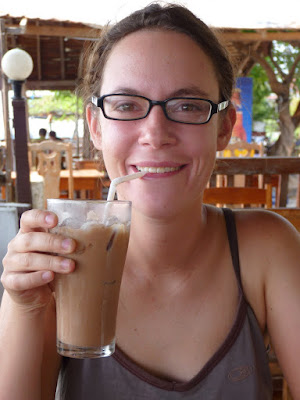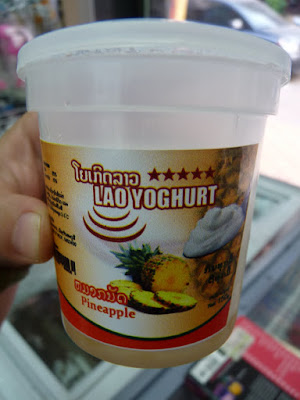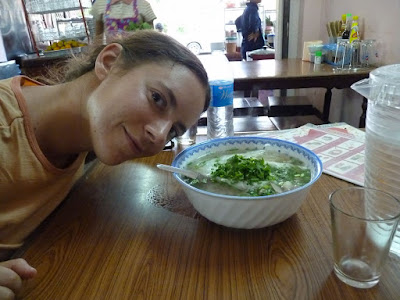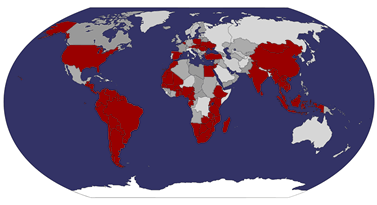Grilled chicken and sausage is very popular in Laos. The chicken is really good and the sausages range from excellent to not-so-sure-what's-inside. Everything in Laos comes with sticky rice, which is a different kind of rice that they soak in water and then steam to make it all stick together. This makes it very easy to pick up huge chunks in your hand and gnaw on it.
 Our first day in Laos, I bought these glutinous mixtures at a local market. It might best be described as coconut jello that has separated into different layers so that the top is more coconuty and the bottom is more sweet.
Our first day in Laos, I bought these glutinous mixtures at a local market. It might best be described as coconut jello that has separated into different layers so that the top is more coconuty and the bottom is more sweet. While we were spending a few hours in the back of a pickup truck, some people ran up to the truck selling food at a stop (common in Laos). One of the women was selling flattened bananas grilled with red seasoning, so I had to try them. The seasoning turned out to be sweet, and I was happy to devour them. Tara thought they were a bit too sweet.
While we were spending a few hours in the back of a pickup truck, some people ran up to the truck selling food at a stop (common in Laos). One of the women was selling flattened bananas grilled with red seasoning, so I had to try them. The seasoning turned out to be sweet, and I was happy to devour them. Tara thought they were a bit too sweet. The closest thing Laos has to a national dish is called laap. It consists of meat (or fish) steamed in a banana leaf with herbs and leaves and then served as a salad of sorts. Because it is both hard to make and popular with tourists, it is overpriced. Tastes decent, though.
The closest thing Laos has to a national dish is called laap. It consists of meat (or fish) steamed in a banana leaf with herbs and leaves and then served as a salad of sorts. Because it is both hard to make and popular with tourists, it is overpriced. Tastes decent, though. I was at the early morning market one day and was hungry. I bought a leaf that I believed was filled with steamed, ready-to-eat laap. Sadly, when I unrolled it, I discovered that it was ready-to-steam and had not been cooked. A week later, I saw another tourist do exactly the same thing. He had already bought it before I could warn him.
I was at the early morning market one day and was hungry. I bought a leaf that I believed was filled with steamed, ready-to-eat laap. Sadly, when I unrolled it, I discovered that it was ready-to-steam and had not been cooked. A week later, I saw another tourist do exactly the same thing. He had already bought it before I could warn him. Also at the morning market, I found an assortment of bugs. The highly amused locals were happy to let me try a few while they laughed. The lower left ones are termite larvae, which don't have much taste, but have a rubbery covering. The ones on the lower right are nice-sized beetles, which are very nice with some seasoning, though they have a bit of an acidic aftertaste.
Also at the morning market, I found an assortment of bugs. The highly amused locals were happy to let me try a few while they laughed. The lower left ones are termite larvae, which don't have much taste, but have a rubbery covering. The ones on the lower right are nice-sized beetles, which are very nice with some seasoning, though they have a bit of an acidic aftertaste. We rarely put things on the blog that we haven't eaten, but we couldn't bring ourselves to eat these popular grilled frogs. I have eaten frog legs a couple of times and don't love them, so it seemed a waste of a perfectly good hopper to order one. That and I wasn't sure what to do with the intestines.
We rarely put things on the blog that we haven't eaten, but we couldn't bring ourselves to eat these popular grilled frogs. I have eaten frog legs a couple of times and don't love them, so it seemed a waste of a perfectly good hopper to order one. That and I wasn't sure what to do with the intestines. Beerlao supposedly has a 99% marketshare in Laos. It was created with the help of German brewers and is widely considered the best beer in Asia. Tara agrees based on her tastings, but it comes in big 22 ounce bottles, which is just about enough to prevent Tara from walking.
Beerlao supposedly has a 99% marketshare in Laos. It was created with the help of German brewers and is widely considered the best beer in Asia. Tara agrees based on her tastings, but it comes in big 22 ounce bottles, which is just about enough to prevent Tara from walking. Iced Ovaltine is really popular in Laos. It is on almost every menu. I associate Ovaltine with really old people, but there are no really old people in Laos, so I guess it is for people like Tara after all.
Iced Ovaltine is really popular in Laos. It is on almost every menu. I associate Ovaltine with really old people, but there are no really old people in Laos, so I guess it is for people like Tara after all. The banh mi in Laos was strangely much better than the banh mi in Vietnam. It had at least 15 types of pork on it, some vegetables, and some hot sauce. And they are much cheaper than Vietnam. And did I mention that it has 15 types of pork? Or at least it seemed that way.
The banh mi in Laos was strangely much better than the banh mi in Vietnam. It had at least 15 types of pork on it, some vegetables, and some hot sauce. And they are much cheaper than Vietnam. And did I mention that it has 15 types of pork? Or at least it seemed that way. Laos imports lots of fake Pocky from Thailand. Pocky is a great concept, but normally disappointing. This blackcurrant flavor was pretty good.
Laos imports lots of fake Pocky from Thailand. Pocky is a great concept, but normally disappointing. This blackcurrant flavor was pretty good. Another Laos specialty is sticky rice patties that are fried and then grilled. Sort of a fried rice nugget. Tara hated it, saying that it tasted like egg. I didn't love it, but decent for ten cents.
Another Laos specialty is sticky rice patties that are fried and then grilled. Sort of a fried rice nugget. Tara hated it, saying that it tasted like egg. I didn't love it, but decent for ten cents. Tara really loved this local pineapple yogurt. She tried a few other flavors that she didn't think were as good. As always, I thought it looked bad despite my love of pineapple.
Tara really loved this local pineapple yogurt. She tried a few other flavors that she didn't think were as good. As always, I thought it looked bad despite my love of pineapple. Sticky rice comes in these wicker baskets. At one restaurant, the sticky rice was really expensive, so when the people from the table behind us left, I grabbed their huge chunk of rice like this. Because I didn't want the waiter to see that I had a huge chunk of rice from the other table, I held it in my hand under the table for the duration of the meal, eating chunks of it when I could.
Sticky rice comes in these wicker baskets. At one restaurant, the sticky rice was really expensive, so when the people from the table behind us left, I grabbed their huge chunk of rice like this. Because I didn't want the waiter to see that I had a huge chunk of rice from the other table, I held it in my hand under the table for the duration of the meal, eating chunks of it when I could. This pho-inspired beef soup was better than most of the pho in Vietnam. It had a crazy combination of herbs, leaves, and flavors. The sausage was also good, but didn't have the crazy, unidentifiable flavor combinations of the soup.
This pho-inspired beef soup was better than most of the pho in Vietnam. It had a crazy combination of herbs, leaves, and flavors. The sausage was also good, but didn't have the crazy, unidentifiable flavor combinations of the soup. Tara and another yogurt. Borrrring. She loved this one, too. I tried to suck the apple strudel flavor from the bottom without getting the yogurt, but it didn't work.
Tara and another yogurt. Borrrring. She loved this one, too. I tried to suck the apple strudel flavor from the bottom without getting the yogurt, but it didn't work. Another Thai import to Laos, these peanuts had been coated and fried in coconut oil. Not as sweet as expected, but pretty good. A slight improvement on the original design of the peanut, though the original is pretty darn good.
Another Thai import to Laos, these peanuts had been coated and fried in coconut oil. Not as sweet as expected, but pretty good. A slight improvement on the original design of the peanut, though the original is pretty darn good. What is this? We weren't sure, either. They didn't seem to object when we wrapped a bit of everything in some of the bigger leaves (which we later saw women picking from the local trees), then dipped the pork-noodle-vegetable-herb-leaf combination in the fish sauce that is everywhere in Asia (and that doesn't actually taste fishy despite coming from an old, rotting fish, I think).
What is this? We weren't sure, either. They didn't seem to object when we wrapped a bit of everything in some of the bigger leaves (which we later saw women picking from the local trees), then dipped the pork-noodle-vegetable-herb-leaf combination in the fish sauce that is everywhere in Asia (and that doesn't actually taste fishy despite coming from an old, rotting fish, I think). This rice porridge, sort of like congee, was so hot that it fogged my camera as I took the picture. The fresh scallions and dried garlic seem strange for breakfast, but sweet breakfast is a foreign concept in most of Asia. I took this in stride by eating both a local breakfast and a sweet breakfast most days.
This rice porridge, sort of like congee, was so hot that it fogged my camera as I took the picture. The fresh scallions and dried garlic seem strange for breakfast, but sweet breakfast is a foreign concept in most of Asia. I took this in stride by eating both a local breakfast and a sweet breakfast most days. The size of this soup made Tara's head look like a joke. We saw small children hiding their whole bodies behind these soups they were so big. I saw an elephant walk behind one and disappear. It was just big enough to hid my fat stomach until I ate all the soup and my stomach expanded to be seen once more.
The size of this soup made Tara's head look like a joke. We saw small children hiding their whole bodies behind these soups they were so big. I saw an elephant walk behind one and disappear. It was just big enough to hid my fat stomach until I ate all the soup and my stomach expanded to be seen once more. Sticky rice desserts are hit-or-miss in Asia. They can be amazing, but many Asians don't love sweets, so they sometimes turn out to be salty, fermenty, or otherwise disgusty. Fortunely, we found an amazing sweets cart in Vientiane (the capital) that sold us some nice treats. Unfortunately, the woman pushed her cart away as soon as she sold these to us and was never seen or heard from again. At least not by us.
Sticky rice desserts are hit-or-miss in Asia. They can be amazing, but many Asians don't love sweets, so they sometimes turn out to be salty, fermenty, or otherwise disgusty. Fortunely, we found an amazing sweets cart in Vientiane (the capital) that sold us some nice treats. Unfortunately, the woman pushed her cart away as soon as she sold these to us and was never seen or heard from again. At least not by us. If you order pork meatballs in Laos, you should expect to get something that looks like this, which looks more like something that Hanibal Lecter might eat than meatballs. They tasted much better than they looked, though the texture was about as bad as it looks.
If you order pork meatballs in Laos, you should expect to get something that looks like this, which looks more like something that Hanibal Lecter might eat than meatballs. They tasted much better than they looked, though the texture was about as bad as it looks. From a distance, we thought we saw people selling huge quantities of fried bacon. It turned out to be fried bananas, but the bananas seemed to have been treated to make them a bit pliable and far more delicious than normal banana chips, though still somewhat less delicious than fried bacon.
From a distance, we thought we saw people selling huge quantities of fried bacon. It turned out to be fried bananas, but the bananas seemed to have been treated to make them a bit pliable and far more delicious than normal banana chips, though still somewhat less delicious than fried bacon. Bread fruit trees, a relative of the durian but with a much better taste, grow the giant fruits right out the side of the trunk. They can grow to be much, much bigger than my head, and my head is pretty big...
Bread fruit trees, a relative of the durian but with a much better taste, grow the giant fruits right out the side of the trunk. They can grow to be much, much bigger than my head, and my head is pretty big... Sweet sticky rice is sometimes eaten for breakfast, though mostly it is found in touristy areas. We had a couple of versions in Luang Prabang, and it makes for a tasty breakfast. It takes about three bites to fill Tara for hours, making it similar to Elven bread.
Sweet sticky rice is sometimes eaten for breakfast, though mostly it is found in touristy areas. We had a couple of versions in Luang Prabang, and it makes for a tasty breakfast. It takes about three bites to fill Tara for hours, making it similar to Elven bread. Laos really, really likes its fruit shakes. You can find them almost everywhere, and they are enjoyed by locals and tourists alike. Fruit is mixed with sugar, ice, condensed milk, and sometimes other sweet liquids before being blended. We averaged about four per day. Each.
Laos really, really likes its fruit shakes. You can find them almost everywhere, and they are enjoyed by locals and tourists alike. Fruit is mixed with sugar, ice, condensed milk, and sometimes other sweet liquids before being blended. We averaged about four per day. Each. At the night market in Luang Prabang, one woman made these eggroll like things by putting a layer of rice milk on a steamer to create a wrapper and then filling it with mushrooms and vegetables. She was really popular and we sat there one night while she made 100 of these things, which took maybe 40 minutes. She sold those for something like $5. Not exactly a high profit business.
At the night market in Luang Prabang, one woman made these eggroll like things by putting a layer of rice milk on a steamer to create a wrapper and then filling it with mushrooms and vegetables. She was really popular and we sat there one night while she made 100 of these things, which took maybe 40 minutes. She sold those for something like $5. Not exactly a high profit business. Also popular in Luang Prabang were buffets were you pay $1.25 and can put as much food on your plate as you can fit. They didn't know what hit them--we have experience in similar schemes and I can now pile a plate three feet high without spilling a thing. Other tourists were oogling my handiwork.
Also popular in Luang Prabang were buffets were you pay $1.25 and can put as much food on your plate as you can fit. They didn't know what hit them--we have experience in similar schemes and I can now pile a plate three feet high without spilling a thing. Other tourists were oogling my handiwork. Most of the food in Laos was not ground-breaking, but most of it was also quite good. Especially outside the touristy areas. Apart from the very good fruit shakes, we probably won't remember any of the individual dishes for long, but the country left a positive impression on our taste buds.
Most of the food in Laos was not ground-breaking, but most of it was also quite good. Especially outside the touristy areas. Apart from the very good fruit shakes, we probably won't remember any of the individual dishes for long, but the country left a positive impression on our taste buds.






 While eating lunch on a rock in the middle of the river, we were lucky enough to spot some rare Irrawaddy river dolphins breaching a little way off. Knowing from experience how hard it is to get a picture of dolphins, we didn't even bother trying, so you'll have to take our word for it.
While eating lunch on a rock in the middle of the river, we were lucky enough to spot some rare Irrawaddy river dolphins breaching a little way off. Knowing from experience how hard it is to get a picture of dolphins, we didn't even bother trying, so you'll have to take our word for it.





 This stone Buddha lives on a pillow at the Wat Si Muang temple. Apparently, if you lift him off his pillow three times, your wish will come true. Andy wished that he would be allowed to stop lifting the Buddha because it was so heavy, and what do you know, his prayer was answered!
This stone Buddha lives on a pillow at the Wat Si Muang temple. Apparently, if you lift him off his pillow three times, your wish will come true. Andy wished that he would be allowed to stop lifting the Buddha because it was so heavy, and what do you know, his prayer was answered!





















